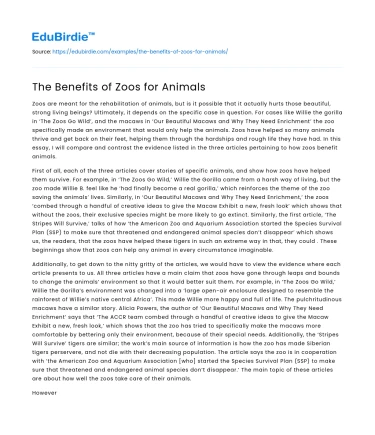Zoos are meant for the rehabilitation of animals, but is it possible that it actually hurts those beautiful, strong living beings? Ultimately, it depends on the specific case in question. For cases like Willie the gorilla in ‘The Zoos Go Wild’, and the macaws in ‘Our Beautiful Macaws and Why They Need Enrichment’ the zoo specifically made an environment that would only help the animals. Zoos have helped so many animals thrive and get back on their feet, helping them through the hardships and rough life they have had. In this essay, I will compare and contrast the evidence listed in the three articles pertaining to how zoos benefit animals.
First of all, each of the three articles cover stories of specific animals, and show how zoos have helped them survive. For example, in ‘The Zoos Go Wild,’ Willie the Gorilla came from a harsh way of living, but the zoo made Willie B. feel like he ‘had finally become a real gorilla,’ which reinforces the theme of the zoo saving the animals’ lives. Similarly, in ‘Our Beautiful Macaws and Why They Need Enrichment,’ the zoos ‘combed through a handful of creative ideas to give the Macaw Exhibit a new, fresh look’ which shows that without the zoos, their exclusive species might be more likely to go extinct. Similarly, the first article, ‘The Stripes Will Survive,’ talks of how ‘the American Zoo and Aquarium Association started the Species Survival Plan (SSP) to make sure that threatened and endangered animal species don’t disappear’ which shows us, the readers, that the zoos have helped these tigers in such an extreme way in that, they could . These beginnings show that zoos can help any animal in every circumstance imaginable.
Save your time!
We can take care of your essay
- Proper editing and formatting
- Free revision, title page, and bibliography
- Flexible prices and money-back guarantee
Additionally, to get down to the nitty gritty of the articles, we would have to view the evidence where each article presents to us. All three articles have a main claim that zoos have gone through leaps and bounds to change the animals’ environment so that it would better suit them. For example, in ‘The Zoos Go Wild,’ Willie the Gorilla’s environment was changed into a ‘large open-air enclosure designed to resemble the rainforest of Willie’s native central Africa’. This made Willie more happy and full of life. The pulchritudinous macaws have a similar story. Alicia Powers, the author of ‘Our Beautiful Macaws and Why They Need Enrichment’ says that ‘The ACCR team combed through a handful of creative ideas to give the Macaw Exhibit a new, fresh look,’ which shows that the zoo has tried to specifically make the macaws more comfortable by bettering only their environment, because of their special needs. Additionally, the ‘Stripes Will Survive’ tigers are similar; the work’s main source of information is how the zoo has made Siberian tigers perservere, and not die with their decreasing population. The article says the zoo is in cooperation with ‘the American Zoo and Aquarium Association [who] started the Species Survival Plan (SSP) to make sure that threatened and endangered animal species don’t disappear.’ The main topic of these articles are about how well the zoos take care of their animals.
However, there are a lot of differences in the articles evidence. Subsequently, in Jaqueline Adams’ article, she describes the tigers as cute and friendly, while describing the jungle as a dangerous place where ‘tiger fathers in the wild don’t help care for their cubs and sometimes try to kill them.’ She creates a tone where the tigers are lucky to be able to be saved. Alternatively, the story of Willie is how he was saved from a trader, so the article was about how Willie had to adapt to the zoo and how they worked. In the beginning, Willie was very unhappy and thought ‘his cage was a real prison’ but when the zoo brought some mates for Willie and put him in an environment that ‘resembled the rainforest of Willie’s native central Africa.’ This shows that even though WIllie was unhappy at first, the zoo was able to meet his needs and make him love his life at the zoo. Lastly, the macaw article discusses the different ways that the zoo helps all kinds of macaws and how many organizations they have created just for them to breed and survive. The article states that ‘Oakland Zoo’s Animal Care, Conservation, and Research team has the privilege and challenge of providing our animal residents with an enriching, well-balanced life and advocating for the conservation of their wild counterparts,’ which shows that the zoos have gone above and beyond for the animals. The articles mutually exist to serve animals, but exclusively have their own resolution of presenting their knowledge and focus on different benefits of having an animals’ very own habitat.
In conclusion, the three articles are all talking about the same thing: how they protect and help animals. Each article tells their own story about how they were able to help an animal species, and how much better their life is because of the zoo. Nevertheless, there is one claim we can mutually sympathize with, zoos do strive to make every living beings life as good as it can get.






 Stuck on your essay?
Stuck on your essay?

